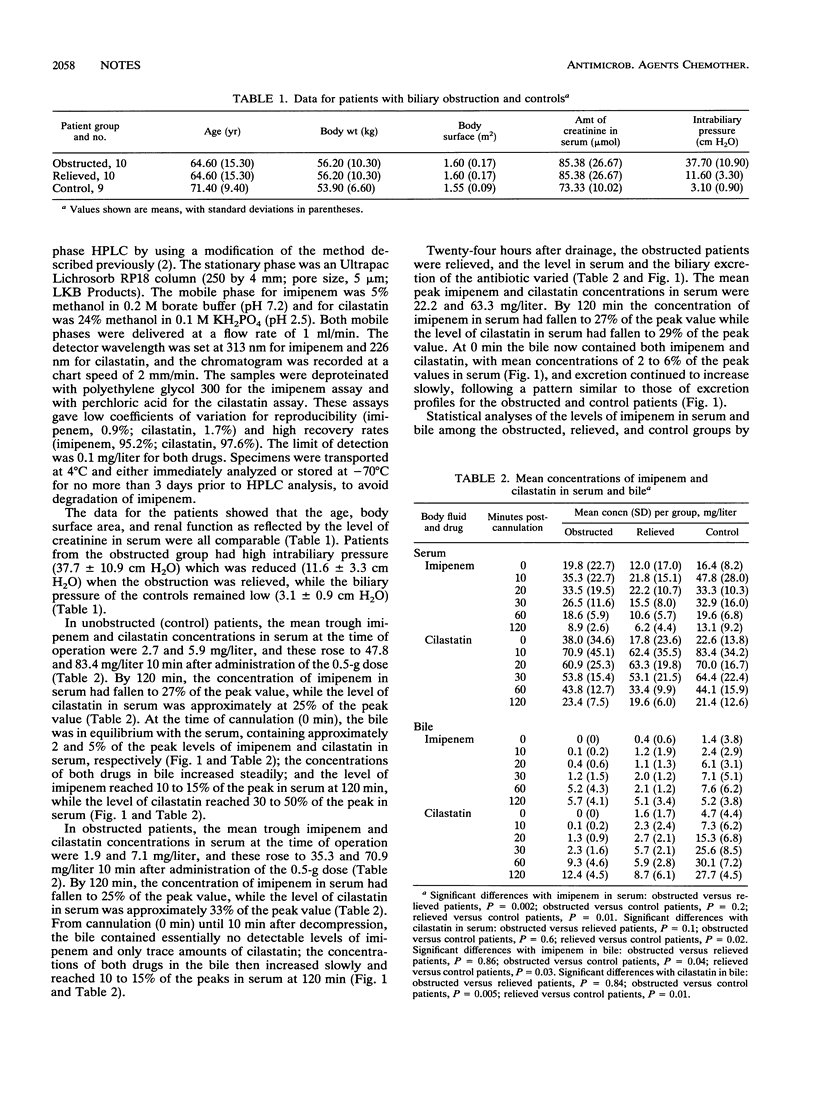Abstract
The biliary excretion of imipenem-cilastatin studied by endoscopic cannulation of the common bile duct in patients with complete obstruction and in a group without obstruction showed that despite a 24-h prophylaxis, the bile obtained from patients with obstruction immediately after cannulation contained neither imipenem nor cilastatin, while there were 2 and 5% of peak concentrations in serum for imipenem and cilastatin, respectively, in the bile from patients without obstruction. Biliary excretion of both compounds increased rapidly after decompression, reaching a maximum of 15% of peak levels in serum within 2 h. Twenty-four hours after drainage, the biliary excretion of the drugs further improved. We conclude that since biliary obstruction impairs excretion of antibiotics, drainage is necessary for the control of sepsis in obstructed cholangitis.
Full text
PDF



Selected References
These references are in PubMed. This may not be the complete list of references from this article.
- Calandra G. B., Wang C., Aziz M., Brown K. R. The safety profile of imipenem/cilastatin: worldwide clinical experience based on 3470 patients. J Antimicrob Chemother. 1986 Dec;18 (Suppl E):193–202. doi: 10.1093/jac/18.supplement_e.193. [DOI] [PubMed] [Google Scholar]
- Chan C. Y., Lai K. N., Lam A. W., Li P. K., Chung W. W., French G. L. Pharmacokinetics of parenteral imipenem/cilastatin in patients on continuous ambulatory peritoneal dialysis. J Antimicrob Chemother. 1991 Feb;27(2):225–232. doi: 10.1093/jac/27.2.225. [DOI] [PubMed] [Google Scholar]
- Cotton P. B., Burney P. G., Mason R. R. Transnasal bile duct catheterisation after endoscopic sphincterotomy: method for biliary drainage, perfusion, and sequential cholangiography. Gut. 1979 Apr;20(4):285–287. doi: 10.1136/gut.20.4.285. [DOI] [PMC free article] [PubMed] [Google Scholar]
- French G. L., Chan R. C., Chung S. C., Leung J. W. Antibiotics for cholangitis. Lancet. 1989 Nov 25;2(8674):1271–1272. doi: 10.1016/s0140-6736(89)91872-2. [DOI] [PubMed] [Google Scholar]
- Jones R. N. Review of the in vitro spectrum of activity of imipenem. Am J Med. 1985 Jun 7;78(6A):22–32. doi: 10.1016/0002-9343(85)90098-1. [DOI] [PubMed] [Google Scholar]
- Keighley M. R., Drysdale R. B., Quoraishi A. H., Burdon D. W., Alexander-Willians J. Antibiotics in biliary disease: the relative importance of antibiotic concentrations in the bile and serum. Gut. 1976 Jul;17(7):495–500. doi: 10.1136/gut.17.7.495. [DOI] [PMC free article] [PubMed] [Google Scholar]
- Kropp H., Gerckens L., Sundelof J. G., Kahan F. M. Antibacterial activity of imipenem: the first thienamycin antibiotic. Rev Infect Dis. 1985 Jul-Aug;7 (Suppl 3):S389–S410. doi: 10.1093/clinids/7.supplement_3.s389. [DOI] [PubMed] [Google Scholar]
- Leung J. W., Chan R. C., Cheung S. W., Sung J. Y., Chung S. C., French G. L. The effect of obstruction on the biliary excretion of cefoperazone and ceftazidime. J Antimicrob Chemother. 1990 Mar;25(3):399–406. doi: 10.1093/jac/25.3.399. [DOI] [PubMed] [Google Scholar]
- Leung J. W., Chung S. C., Sung J. J., Banez V. P., Li A. K. Urgent endoscopic drainage for acute suppurative cholangitis. Lancet. 1989 Jun 10;1(8650):1307–1309. doi: 10.1016/s0140-6736(89)92696-2. [DOI] [PubMed] [Google Scholar]
- Leung J. W., Emery R., Cotton P. B., Russell R. C., Vallon A. G., Mason R. R. Management of malignant obstructive jaundice at The Middlesex Hospital. Br J Surg. 1983 Oct;70(10):584–586. doi: 10.1002/bjs.1800701006. [DOI] [PubMed] [Google Scholar]
- Leung J. W., Sung J. Y., Costerton J. W. Bacteriological and electron microscopy examination of brown pigment stones. J Clin Microbiol. 1989 May;27(5):915–921. doi: 10.1128/jcm.27.5.915-921.1989. [DOI] [PMC free article] [PubMed] [Google Scholar]
- Mortimer P. R., Mackie D. B., Haynes S. Ampicillin levels in human bile in the presence of biliary tract disease. Br Med J. 1969 Jul 12;3(5662):88–89. doi: 10.1136/bmj.3.5662.88. [DOI] [PMC free article] [PubMed] [Google Scholar]
- Norrby S. R., Björnegård B., Ferber F., Jones K. H. Pharmacokinetics of imipenem in healthy volunteers. J Antimicrob Chemother. 1983 Dec;12 (Suppl 500):109–124. doi: 10.1093/jac/12.suppl_d.109. [DOI] [PubMed] [Google Scholar]
- Ohnhaus E. E., Halter F., Lebek G. Estimation of the biliary excretion of different cephalosporins utilizing retrograde cholangio-pancreatography (ERCP). Endoscopy. 1981 Jan;13(1):31–32. doi: 10.1055/s-2007-1021638. [DOI] [PubMed] [Google Scholar]
- REYNOLDS B. M., DARGAN E. L. Acute obstructive cholangitis; a distinct clinical syndrome. Ann Surg. 1959 Aug;150(2):299–303. doi: 10.1097/00000658-195908000-00013. [DOI] [PMC free article] [PubMed] [Google Scholar]
- Thomas M. Antibiotics in bile. J Antimicrob Chemother. 1983 Nov;12(5):419–422. doi: 10.1093/jac/12.5.419. [DOI] [PubMed] [Google Scholar]


